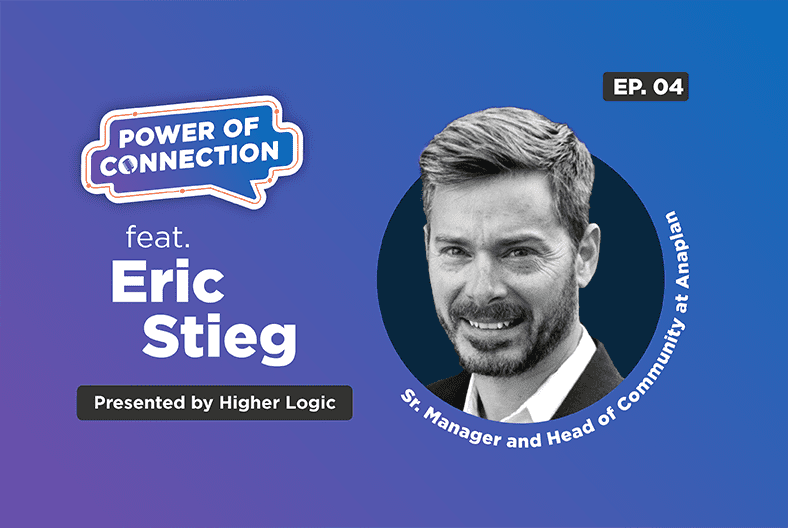
Why Engagement—Not Revenue—Is the Most Important KPI for Your Community with Eric Stieg
When Eric Stieg interviewed for a community role, he didn’t expect a question about KPIs to turn into one of his most memorable conversations.
The interviewer asked: What’s the most important KPI for communities?
“Engagement,” Eric answered without hesitation. The pause that followed told him they were expecting a different answer—something like revenue.
Eric gets it. Revenue is what executives default to. “But so many things need to come first,” he explained. “Engagement is the foundation. It’s what enables a community to drive ARR, growth, and every other meaningful outcome.”
As senior manager and head of community at Anaplan, Eric has spent years proving that engagement isn’t just a feel-good metric—it’s the single most important one. And yet, many companies still treat it as secondary, expecting quick returns when, in reality, strong communities take time, consistency, and the right engagement strategy to drive long-term success.
So what does it really mean to put engagement first? Let’s dive in.
Note: elements of this content have been edited for concision and clarity.
Engagement: The Starting Line for Community Success
Think of your community like a party. If you walk in and see a few scattered guests avoiding eye contact, you’ll probably leave. But if the room is buzzing with conversations, laughter, and introductions, it’s hard not to feel drawn in.
That’s what engagement does. It creates energy and purpose, making people want to participate. It’s not about how many people show up. It’s about whether they feel encouraged to connect, contribute, and return.
Eric explains it like this: “If I visit a community and see no signs of life—no recent posts, no visible activity—I’m not staying. Even if people are logged in, if the last post is a month old, it feels like a ghost town. Without signs of life and recency, you lose members before they even start.”
This is why engagement has to come first. Without it, other goals—customer retention, product feedback, even revenue—become impossible to achieve.
Start with Value, Not Demands
Many companies make the mistake of expecting engagement to materialize without first offering value. Communities can’t simply exist as forums for questions and answers. They have to give members a reason to invest their time.
As Eric puts it: “You need to understand what members are looking for. Is it connecting with peers? Exclusive access to your product team? A space to build skills? Once you figure that out, everything else becomes easier. Members show up, stick around, and contribute in ways that matter to them, and engagement takes care of itself.”
At Anaplan, this value-first approach is baked into their community content strategy. They meet members where they are, offering tailored onboarding resources and an à la carte menu of participation options—blogs, videos, podcasts—so members can engage in ways that make sense for them.
Engagement Fuels Business Outcomes, But It’s a Long Game
Too often, companies expect engagement to deliver immediate results. But community impact builds over time through consistent interaction and participation. The real question is whether that investment translates into measurable business value.
Eric’s team set out to find the answer, analyzing 400 customers to understand the link between engagement and business outcomes. The findings were striking:
- 95% of expanded customers had community accounts, compared to just 60% of churned customers.
- Expanded customers visited the community 5x more often than those who churned.
- Companies that expanded had 3x as many community accounts as those that churned.
The numbers left no doubt: the most engaged customers were also the most likely to stay, grow, and advocate for Anaplan.
“Revenue is the goal, but engagement is the engine that drives it,” Eric explained. It leads to stronger retention, better advocacy, and, ultimately, revenue growth. But none of that happens unless engagement is the priority.
Shifting the Conversation Around Communities
For organizations hesitant to invest in engagement, Eric reframes the value of community: it’s not just a place for conversation; it’s where your brand, values, and expertise come to life in real time.
Your customers are already talking about you. The question is: Do you want that conversation happening on platforms you don’t control, or in a space you own and contribute to?
“Would you rather have customer conversations scattered across 100 different websites, where you can’t scale or respond effectively, or in a community you own?” Eric asked. “When someone post something incorrect in your community, you can address it directly, clarifying for everyone and shaping the narrative in the process.”
When companies treat engagement as a top KPI, communities stop being cost centers and start becoming competitive moats.
Join the Full Conversation
To hear more from Eric on strategies for sparking user-generated content, incentivizing super users, and building an active community, subscribe and catch the full episode.

